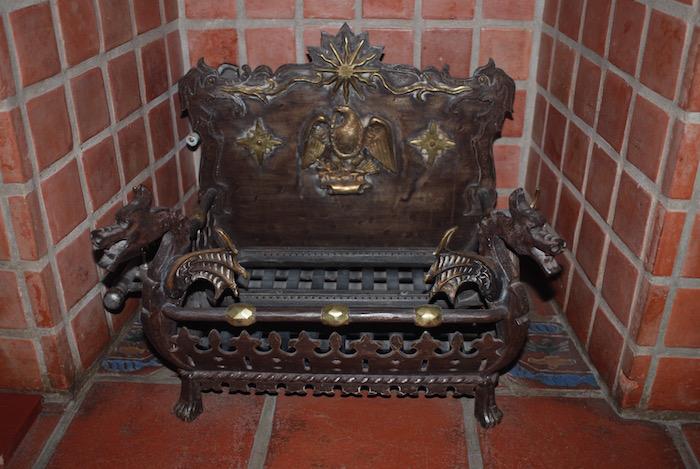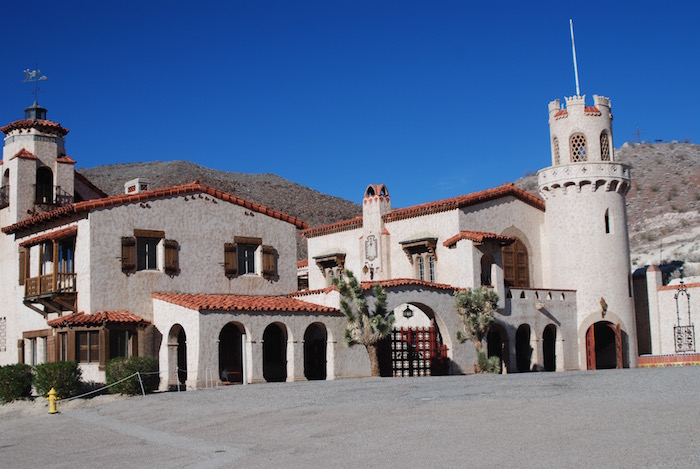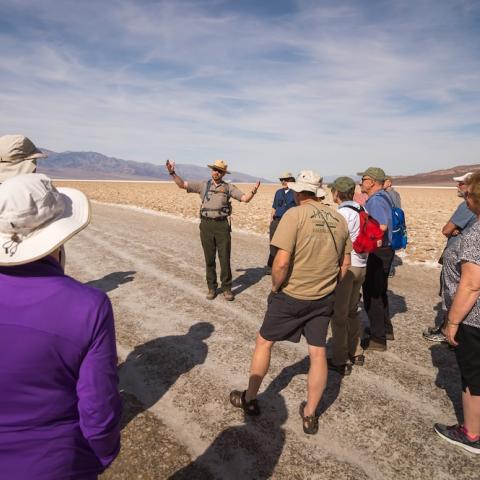When Albert Johnson had his villa built in Grapevine Canyon in what is now Death Valley National Park, floods likely were not factored into the design. Nevertheless, the Mission Revival-influenced "castle" held up remarkably well during the torrential rains and flooding of last October. The same, however, cannot be said of the infrastructure surrounding the 32,000-square-foot mansion.
"Luckily, the castle itself was not hit directly by the mud and debris flow. It had some pretty serious leaks and roof and wall problems, but nothing like the other buildings like the Hacienda building where the offices and the visitor center, which is also known as the garage and long shed, which had three and in some cases more feet of mud and debris deposited in it," Death Valley Superintendent Mike Reynolds explained during a recent phone call. "Those really took a hammering, but the buildings themselves are structurally repairable. And everything that really matters is fixable. But I would say because of the complete loss of all the utilities, like the water system, the sewer system, the gas system, the electric system, both internal and external, the phone system, all of that is gone completely and needs total replacement."
Johnson, who made his fortune from mining, insurance, and other business ventures, had thought he was investing in a gold mine in 1904 when Walter Scott came to Chicago looking for backers. It turned out to be a flimflam, but after a trip to Death Valley to see the mine in person, Johnson found the dry, hot climate good for his health. In 1927, he had his mansion built in Grapevine Canyon, though it became known as "Scotty's Castle" after Scott promoted Johnson's home as his own.

All the furnishings within Scotty's Castle are being moved off-site until repairs to the mansion and its infrastructure can be completed/Kurt Repanshek file photo.
Not only is this villa with its turrets and enormous swimming pool seemingly out of place in the high desert, but its design seemingly pushed the technological limits of the 1920s. Johnson saw that there was a solar heating system at work, and he also had a Pelton water wheel turbine installed to generate electricity for the place. Too, an evaporative cooling system employed indoor waterfalls and even wet burlap to keep things inside the castle relatively cool on hot 100-degree summer days.
Inside the home was ornately decorated, with copper pots and pans in the kitchen, decorative floor tiles, elaborate tapestries hanging on the walls, chandiliers and sconces, massive fireplaces, heavy draperies, plush furniture, and elaborate hardware on shutters, windows, doors, and even fireplace grates. In the garages were kept 1920s and '30s automobiles that belied the depression gripping the rest of the nation.
The storms of last October crippled the castle, however, by destroying 10 miles of road running up Grapevine Canyon to the castle's parking lots and tearing out power lines and water and sewer systems.
“The patient is not dead. In fact, while closed indefinitely ... we are actively working to get it back on its feet again," Superintendent Reynolds said. "We’re estimating that there’s $50 million in damage to the roads and Scotty’s Castle infrastructure. By order of magnitude, it's certainly the costliest flood in the history of Death Valley and many times the magnitude of any recent flood."
The recovery will not be quick. It currently is expected to take 18 months before visitors can return to Scotty's Castle, and even then the visitor's center and staff offices probably won't be back in operation, the superintendent said. Five years could pass before everything is back up and running.
But, in a sort of bad news, good news, way, when the repairs are finished, the castle should be in much better physical shape than it was before the flooding.
"Much of the infrastructure at the castle was in severe deferred maintenance. A lot of backlogged challenges with trying to maintain a historic site, very costly, and competing for limited dollars," said Superintendent Reynolds. "And this was pre-flood. Now, it’s going to get fixed right. The water system, for example, is completely destroyed, every bit of it. When you put it back, you don’t put back an 80-year-old crumbling water system. You put in a new one that works well, with adequate capacity, and meets state standards, and all of the things that we were struggling with before.
“If we can get through the next couple of years, it’s going to actually have a lot of improved stability, particularly with the utilities, and infrastructure.”

Though never filled during Albert Johnson's life, the swimming pool at Scotty's Castle was filled with flood waters, mud, and debris by the October storm/NPS
Part of the challenge of getting it "fixed right" is getting the dollars to pay for all the repairs, and many are needed. While Scotty's Castle had minimal damage from rain seeping in through the roof or the walls, flooding filled the sprawling swimming pool (which was never filled during Johnson's life) adjacent to the mansion. Below-water-surface windows that allowed views from the castle's basement into the pool broke under the water pressure and flooded the basement with mud and other debris.
“The stuff in the basement of the castle was hit really hard with mud. We were just talking about the tiles, tiles that were intended to be used in various parts of the castle during construction when it was under construction. There are hundreds and thousands of them, and of course significant mud and debris flow came through the tunnels, which are now embedded in those tiles," said Superintendent Reynolds. "So we were just putting together this morning a plan for how to clean those, which means you have to one-by-one by hand move hundreds of thousands of tiles, brush them off with a brush, and then once you have cleared an area use a hose and water to clean that area, then everything has to be dried, once it’s dry you can rack them back in. To do that properly, that’s 'man months' of labor to take care of them. But we want to make sure that they are taken care of properly because the mud can over time adversely impact the parts of the collection, through mold and rust.”
Then, of course, there are the furnishings of the castle itself. All, told, the superintendent estimated, there are 65,000 "museum objects" the need to be protected. With no electricity and no water, there are no humidity controls or firefighting capabilities. Until those are restored, the objects will be moved off-site and properly stored.
"We don’t have adequate storage in the park away from Scotty’s Castle. We do have a collection facility at park headquarters, but it’s not big enough to accommodate the collection, so we’re going to move them out of the park to a place that can meet those standards, at least for the interim," Superintendent Reynolds said. "They’ll be stored there until we can get the facilities back in condition to move them back in.”

Albert Johnson saw that his Death Valley home was ornately furnished, even down to fireplace grates/Kurt Repanshek file photo
The Welte-Mignon theater pipe organ in the castle's Upper Music Room will remain on site, as will the antique vehicles, one of which was a 1914 Packard Touring Limousine.
"We’re going to mothball those and protect them in place. We’ve determined that the cost, or the risk, of moving things like the organ are so complex and sensitive it would exceed the risks to being in the condition that they’re at now," he said. "There are ways you can mothball, especially the vehicles. We’ll protect them as much as possible from the rodents and the humidity and the different environmental impacts that we’re anticipating, or experiencing."
As to paying for all these repairs, well, fortunately there are avenues within the National Park Service that can be tapped for such emergencies.
"I would say that our current plan is redirecting funds from several fund sources, in particular the gate receipts from visitors at Death Valley National Park, as well as some maintenance fund sources that are repair/rehab that are used for deferred maintenance across the Park Service," the superintendent said. "The Park Service has pretty good planning for emergencies. They don't always happen in Death Valley, but given the diversity of national parks, there are 409 of them scattered all across the country, they happen somewhere, especially with climate change, more and more frequently, so the Park Service is pretty good about having the ability to redirect project funds from other parks to target disaster recovery.
“It’s not perfect, they don't have $50 million sitting around, but they’re really good at sort of planning that and being able to shuffle the checkers around and being able to delay some other projects to cover that. So that’s our current plan."
Scotty likely would approve. Ironically, his gravesite on a hillside overlooking the castle was not damaged by the storm.

Ten miles of road running up Grapevine Canyon were destroyed by the October floods and will have to be rebuilt/NPS
Not without some irony, water has turned up before during Superintendent Reynolds' Park Service career. He was the superintendent of the National Park of American Samoa when a tsunami struck in September 2009. A series of four waves spawned by a magnitude 8.0 earthquake left the building that houses the park headquarters and visitors center in ruins, with a car dangling from a second-story balcony and muck coating much of the first floor.
"It destroyed the visitor center, the collection, all of our stuff, and then we spent the next two-and-a-half years reestablishing a new headquarters and replacing our fleet, which was all washed away, and just getting the collection shipped off to conservators, repaired, and then shipped back and getting the park back on its feet," he recalled. “That was great practice for this flood, which by order of magnitude is about 25 times the complexity and cost.
"From a recovery standpoint, putting a whole campus back together that is 90 years old, or 80 years old, is more complex than replacing modern cars and fixing wooden things and baskets.”






 Support Essential Coverage of Essential Places
Support Essential Coverage of Essential Places







Comments
I visited the castle a couple years back. Its a real piece of history and a fun place to tour.
I wish them the best in getting this dealt with. It looks like an enormous challenge.
In my three visits to Death Valley during in my lifetime, Scotty's Castle was always a favorite stop. Despite the sadness of the destruction, glad the castle and environs are in capable hands. I currently live and work in a country (Thaiand) which has developed its national parks after the USA model. Thanks for providing worldwide leadership in preserving nature and history. Kudos to the USA National Park Service.